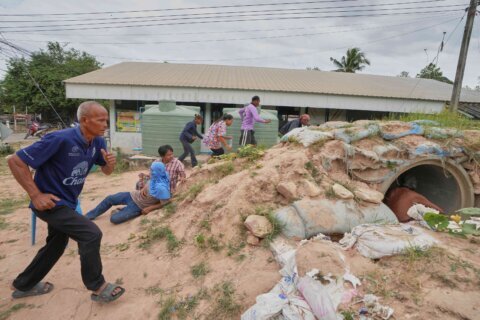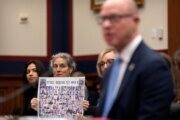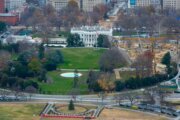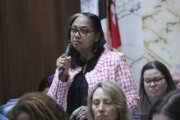WASHINGTON — Asking kids “How was school today?” can be a frightening question for many parents whose children live in a reality where lockdown drills and learning to shelter in place are the norm.
Practicing for an active shooter situation became routine for many schools after the Columbine shooting. In the past 20 years, there have been about 500 school-associated violent deaths, the Associated Press reports. And companies are capitalizing on the terrifying statistics, marketing bulletproof blankets and backpacks.
“It’s scary, because you think there are so many schools and what are the chances, but it happens a lot,” says Katy Greenberg, a Bethesda, Maryland, mom.
Her 7-year-old has been doing lockdown drills since kindergarten.
Greenberg, who says her daughter is not frightened by the drills since they are part of her school’s procedure. “You start school and you just kind of learn how to follow these rules. To them, the drills are just something they do.”
Despite the fact that 74 school shootings have occurred since the shooting at Sandy Hook Elementary 18 months ago, Stephen Brock, president of the National Association of School Psychologists, says the probability of an active shooter situation at a school is relatively low.
“But schools need to be prepared for everything — from a loose dog, to bad weather, to neighborhood incidents,” he says.
Alexandria mom Amy Fortney Parks’ two kids experienced a lockdown recently when a shooting happened in their neighborhood.
“The biggest reality came when we had the recent murder of Ruthanne Lodato,” says Fortney Parks, a child psychologist who has worked in the Fairfax school system for 20 years.
“I didn’t necessarily panic, but it was somewhat stressful,” she says.
Most public schools have mandatory lockdown drills, and a certain number are required yearly by each state. Parents are usually kept up-to-date about the drills by the school.
“Earlier this year, I sent out a letter to parents detailing all of the precautions we take to keep their children safe,” says Judy Lewis, principal of Burning Tree Elementary School in Montgomery County.
Some parents, such as Julieta Macias of Rockville, Maryland, like to ask their children about the drills.
Macias says she asks about “what happened, how do they feel about it, were they concerned or fearful?” She says her children’s familiarity with the drills makes them feel more comfortable and prepared, should anything happen.
Brock says when best practices are followed during drills, students have less anxiety about the threatening situations they might face.
“It makes it perceived as being more controllable,” he says. “Drills give kids something to do to address something they are anxious about.”
Lewis says lockdown drills are the new normal.
“It’s a world our kids are gonna have to swim in,” she says.
But she echoes what a lot of educators hope parents will remember.
“Kids need to know what to do, but they also need to know they are safe in this school; this is a good place to be. We will take care of you.”
How do you address lockdowns and potential school shootings with your children? Let us know in the comments section of this story, on Twitter or on the WTOP Facebook page. Until then, a local parent talks about being prepared.
Chasing dinosaurs: From fire drills to lockdown scares
Molly Meiners, Parenting Contributor
Fire drills were a regular part of the school year when we were young. As a teenager, it was a fun excuse to get out of class for 20 minutes. In elementary school, however, fire drills scared me half to death.
To be fair, the drills probably inflicted a fair amount of pain on my parents, too, as afterwards I would barrage them with questions: What was our fire safety plan? Had we checked the batteries in our smoke detectors? Had we replaced our fire extinguishers?
Why didn’t I have a rope ladder I could throw out my window to climb to safety? Where was our family meeting place? (For the record, our closest neighbor was nearly 1 mile away across a corn field. Where did I think we were going to meet? The local Starbucks?)
My dad answered my questions by telling me we didn’t need those things because our house wasn’t going to catch on fire, and if it did, his only job was to get my sister and me out safely. (My mom was obviously on her own.)
This made me feel better, and after a couple of days I forgot all about fire safety until the following year.
The once ominous fire drills seem like recess, compared to the lockdown drills our children experience today. In schools across the nation, teachers and children practice how to be prepared for an intruder or criminal activity.
Teachers and faculty work with police to design the best way to fortress the school and protect the children. Detailed plans include hiding in closets and bathrooms, turning off lights and pulling blinds, locking doors, shutting down cellphones and keeping silent to avoid detection.
My preschool-aged child experienced a real-life lockdown this year after a shooting occurred one morning nearby his school. Parents were later told the teachers huddled children in the bathrooms and other remote areas, challenging them to see how quiet they could be.
The littlest ones were given glow sticks to hold in the dark. Some practiced how softly they could sing a song. Others were told they had to keep silent because they were on a dinosaur hunt; if police or firemen came into the school it was because they were looking for the dinosaurs to take back to the museum.
The school couldn’t have responded better. Parents were made aware — notably that the children were safe — and kept updated on the situation through calls and emails.
A very detailed report of the day — including individual accountings from each teacher — was sent to the parents that evening. Following the all-clear, the staff did an immediate debrief of the situation to discuss how it was handled and what would have been done had the situation deteriorated.
I fully recognize that our children are safer due to the detailed planning of school faculty and law enforcement, as well as lockdown drills. A coordinated plan helps students know what to do and allows them to respond to danger in a swift and brave manner.
But how do we explain to our children the absolutely horrific reasons for lockdown drills? How do we strike the balance of making them aware of the dangers without making them scared of the place they should feel safest outside of their own homes?
When I was young, the idea of a school fire seemed remote, at best. Today, the idea of an intruder in a school has proven to be real many times over.
With youth comes innocence. My child never mentioned anything being different about the school day, and given his young age, we decided not to ask. I’m guessing parents of the older children had a very different evening, with lots of hugs, tears and calming words.
The innocence will be short lived. Soon, my child and his classmates will be bigger and will no longer be blissfully unaware






